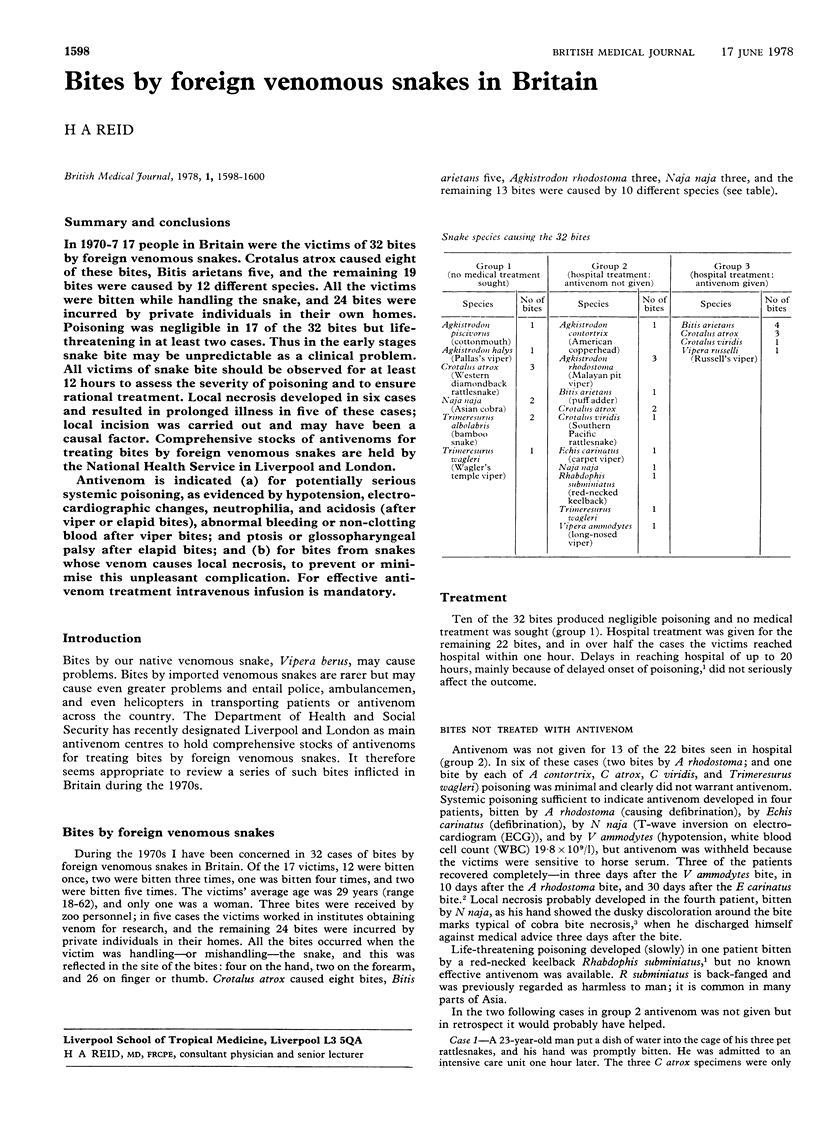Abstract
In 1970-7 17 people in Britain were the victims of 32 bites by foreign venomous snakes. Crotalus atrox caused eight of these bites, Bitis arietans five, and the remaining 19 bites were caused by 12 different species. All the victims were bitten while handling the snake, and 24 bites were incurred by private individuals in their own homes. Poisoning was negligible in 17 of the 32 bites but life-threatening in at least two cases. Thus in the early stages snake bite may be unpredictable as a clinical problem. All victims of snake bite should be observed for at least 12 hours to assess the severity of poisoning and to ensure rational treatment. Local necrosis developed in six cases and resulted in prolonged illness in five of these cases; local incision was carried out and many have been a casual factor. Comprehensive stocks of antivenoms for treating bites by foreign venomous snakes are held by the National Health Services in Liverpool and London. Antivenom is indicated (a) for potentially serious systemic poisoning, as evidenced by hypotension, electrocardiographic changes, neurtrophilia, and acidosis (after viper or elapid bites), abnormal bleeding or non-clotting blood after viper bites; and ptosis or glossopharyngeal palsy after elapid bites; and (b) for bites from snakes whose venom causes local necrosis, to prevent or minimise this unpleasant complication. For effective antivenom treatment intravenous infusion is mandatory.
Full text
PDF


Selected References
These references are in PubMed. This may not be the complete list of references from this article.
- Christensen P. A. The treatment of snakebite. S Afr Med J. 1969 Oct 11;43(41):1253–1258. [PubMed] [Google Scholar]
- Cooper J. E., Reid H. A. Ionides and snake bite. Trans R Soc Trop Med Hyg. 1976;70(3):264–265. doi: 10.1016/0035-9203(76)90064-x. [DOI] [PubMed] [Google Scholar]
- Mather H. M., Mayne S., McMonagle T. M. Severe envenomation from "harmless" pet snake. Br Med J. 1978 May 20;1(6123):1324–1325. doi: 10.1136/bmj.1.6123.1324-a. [DOI] [PMC free article] [PubMed] [Google Scholar]
- REID H. A., THEAN P. C., CHAN K. E., BAHAROM A. R. Clinical effects of bites by Malayan viper (Ancistrodon rhodostoma). Lancet. 1963 Mar 23;1(7282):617–621. doi: 10.1016/s0140-6736(63)91268-6. [DOI] [PubMed] [Google Scholar]
- REID H. A., THEAN P. C., MARTIN W. J. SPECIFIC ANTIVENENE AND PREDNISONE IN VIPER-BITE POISONING: CONTROLLED TRIAL. Br Med J. 1963 Nov 30;2(5369):1378–1380. doi: 10.1136/bmj.2.5369.1378. [DOI] [PMC free article] [PubMed] [Google Scholar]
- Theakston R. D., Reid H. A. Effectiveness of Zagreb antivenom against envenoming by the adder, Vipera berus. Lancet. 1976 Jul 17;2(7977):121–123. doi: 10.1016/s0140-6736(76)92846-4. [DOI] [PubMed] [Google Scholar]
- Warrell D. A., Ormerod L. D., Davidson N. M. Bites by puff-adder (Bitis arietans) in Nigeria, and value of antivenom. Br Med J. 1975 Dec 20;4(5998):697–700. doi: 10.1136/bmj.4.5998.697. [DOI] [PMC free article] [PubMed] [Google Scholar]


